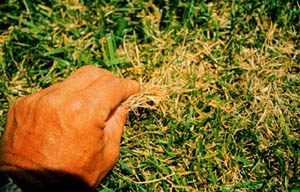Billbugs




Identification
Adult billbugs are weevils 1/5 to 3/4 inch long. The reddish-brown to black adults have a pair of jaws at the tip of a long snout or "bill'. The young are white, legless grubs about 3/8 inch in length with the rear end wider than the head. The "hunting billbug" is the most common type found in Georgia. It occurs throughout the state.
Life Cycle and Biology
Adults feed above ground and deposit eggs in the stems of host grasses. Hatching larvae feed within the stems; larger larvae feed on the crown; mature larvae feed on the roots of the turf. One generation occurs annually, but adults and larvae may be found at any time of year.
Damage
Zoysiagrass and bermudagrass are most often injured, but feeding may occur on many grasses. When infestations are heavy, roots of grass are destroyed and the turf is killed in irregular patches. Early damage resembles dollar spot disease in small spots of dead or dying grass. The most damage occurs in June and July. Damage from billbugs differs from white grub or mole cricket injured turf in that infested soil usually stays firm.
Control Strategies
Varieties of turf resistant to billbug damage are available and should be considered when establishing a new lawn in an area with a history of billbug problems. Maintaining constant soil moisture and moderate fertility levels during the fall months into winter helps mask damage by low-moderate infestations. An insecticide application in mid- to late-May and repeated in June can help reduce adult activity.
